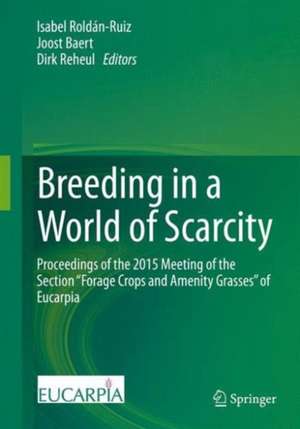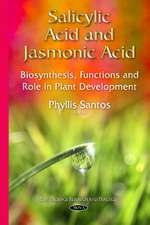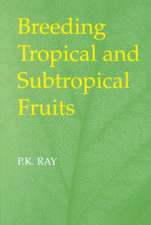Breeding in a World of Scarcity: Proceedings of the 2015 Meeting of the Section “Forage Crops and Amenity Grasses” of Eucarpia
Editat de Isabel Roldán-Ruiz, Joost Baert, Dirk Reheulen Limba Engleză Hardback – 14 iun 2016
| Toate formatele și edițiile | Preț | Express |
|---|---|---|
| Paperback (1) | 1046.97 lei 39-44 zile | |
| Springer International Publishing – 30 mai 2018 | 1046.97 lei 39-44 zile | |
| Hardback (1) | 1057.93 lei 39-44 zile | |
| Springer International Publishing – 14 iun 2016 | 1057.93 lei 39-44 zile |
Preț: 1057.93 lei
Preț vechi: 1392.01 lei
-24% Nou
Puncte Express: 1587
Preț estimativ în valută:
202.44€ • 211.79$ • 168.16£
202.44€ • 211.79$ • 168.16£
Carte tipărită la comandă
Livrare economică 31 martie-05 aprilie
Preluare comenzi: 021 569.72.76
Specificații
ISBN-13: 9783319289304
ISBN-10: 3319289306
Pagini: 305
Ilustrații: XI, 337 p. 72 illus., 28 illus. in color.
Dimensiuni: 178 x 254 mm
Ediția:1st ed. 2016
Editura: Springer International Publishing
Colecția Springer
Locul publicării:Cham, Switzerland
ISBN-10: 3319289306
Pagini: 305
Ilustrații: XI, 337 p. 72 illus., 28 illus. in color.
Dimensiuni: 178 x 254 mm
Ediția:1st ed. 2016
Editura: Springer International Publishing
Colecția Springer
Locul publicării:Cham, Switzerland
Public țintă
ResearchCuprins
Part I . Scarcity of natural resources.- Part II. Scarcity of breeders.- Part III. Scarcity of land.- Part IV. Scarcity of focus.- Part V. Reports of interactive sessions
Textul de pe ultima copertă
This book includes papers presented at the 2015 meeting ofthe Fodder Crops and Amenity Grasses Section of Eucarpia. The theme of themeeting “Breeding in a world ofscarcity” was elaborated in four sessions: (1) scarcity of naturalresources, (2) scarcity of breeders, (3) scarcity of land and (4) scarcity offocus. Parts I to IV of this book correspond to these four sessions. Session 1refers to the consequences of climate change, reduced access to naturalresources and declining freedom in using them. Plant breeding may help bydeveloping varieties with a more efficient use of water and nutrients and abetter tolerance to biotic and abiotic stresses. Session 2 refers to the shrinkingnumber of field breeders. There is aneed for a mutual empathy between field- and lab-oriented breeding activities,integrating new methods of phenotyping and genotyping. Session 3 underscoresthe optimal use of agricultural land. Forage needs to be intensively produced in a sustainable way, meetingtheenergy, protein and health requirements of livestock. Well-adaptedvarieties, species and mixtures of grasses and legumes are needed. Session 4refers to the fading of focus in primary production triggered by a rangeof societal demands. There are few farmers left and they are asked to meet many consumer demands. Bothlarge-scale, multi-purpose species and varieties and specialized niche cropsare required. Part V summarizes the conclusions of two open debates, twoworking group meetings and two workshops held during the conference. Thedebates were devoted to the future ofgrass and fodder crop breeding,and to feed quality breeding andtesting. The conference hosted meetings of the working groups “Multisiterust evaluation” and “Festulolium”. Workshops focused on “genomic selection and association mapping” and on “phenotyping”with applications in practical breeding research. Part V contains also shortsketches of breeding ideas presented as short communications.
Caracteristici
This book provides an update of the recent research in fodder crops and grass breeding This book contains the reports of lively debates and workshops on the future of breeding, the implementation of evaluation methods that estimate feeding value, recent advances in phenotyping and genomic selection, highlighting future perspectives in breeding and breeding research of grasses and fodder crops This book contains the proceedings of a meeting attended by 124scientists or breeders from 25 countries in Europe and overseas, veryrepresentative for the grass and fodder crops breeding community






